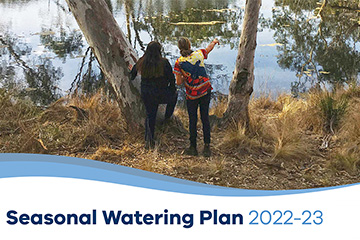Flooding interrupts platypus breeding season
02 November 2016
The North Central Catchment Management Authority (CMA) says recent flooding in the Campaspe and Loddon rivers is likely to have prevented the successful breeding this season of one of Australia's most iconic animals.
The September and October flooding of the Campaspe and Loddon rivers occurred at a critical time for baby platypus, leading Australian Platypus Conservancy Biologist Dr Melody Serena to emphasise the importance of future environmental flows down the two waterways.
"October is the peak time of year when females incubate their eggs and eggs hatch in burrows in the banks of streams and rivers. Platypus eggs are quite small and newly hatched babies are only about as big as a jelly bean," she said.
"During floods like the ones we just saw, platypus nursery burrows will fill with water and the eggs and babies will be lost. Although the mothers themselves are expected to survive, they simply aren't equipped to move their eggs or small offspring to safety as flood waters rise.
"So, in terms of reproduction, the populations in the Campaspe and the Loddon have taken a big hit this year."
Dr Serena said environmental flows in the Campaspe and the Loddon over the next year will be vital to allow platypus breeding to be successful.
"It is going to be really, really important to try to keep flows up in the rivers," she said.
"Because platypus reproduction uses so much energy, the females don't even try to breed if they are not in really good physical condition in spring. For that to occur, they need a long period of favourable flow in the months leading up to breeding so they can feed on plenty of aquatic bugs and store fat.
"If we want to keep the platypuses breeding, which we certainly do next year, it's going to be really important to ensure that flows are right in coming months, particularly from late summer through winter."
Dr Serena said the platypus populations in both rivers, especially in the Campaspe downstream of Lake Eppalock, were integral to conserving this species in the wider region.
"The platypus population downstream from Echuca in the Murray River is critically endangered," she said.
"The other known animals are in the Gunbower system, where probably fewer than 50 animals remain."
"The Campaspe is a really important source of juveniles and with the right conditions they can migrate to the Murray and potentially start to recolonise it."
The North Central CMA's Environmental Water Manager Louissa Rogers said the CMA would work with Dr Serena and the local community and stakeholders over the next couple of years to focus on the health of the rivers.
"Floods can be beneficial for rivers and, overall they are," she said.
"But a natural flood doesn't do everything a managed environmental flow can. Before climate change and regulation, animals like platypuses once had population buffers that meant populations would survive the 'bust' extreme events like droughts and floods.
"Managed environmental flows are important to help produce conditions that can create to build populations numbers so that they are resilient to the extreme events.
"We need to carefully manage our flows over the next few platypus breeding seasons to rehabilitate the populations and build up that in-stream vegetation.
"The flows will also be important for native fish. They are expected to lay a lot of eggs in the coming season, and it is important the conditions are right to ensure they thrive."
Environmental flows are authorised by the Victorian Environmental Water Holder in line with its Seasonal Watering Plan 2016-17 in partnership with Goulburn Murray Water. Regular watering updates posted on the North Central CMA website nccma.vic.gov.au.
Further Information
Anthony Radford, Communications Coordinator
North Central Catchment Management Authority
E: anthony.radford@nccma.vic.gov.au
Tel: 03 5440 1884 or 0409 720 610.


